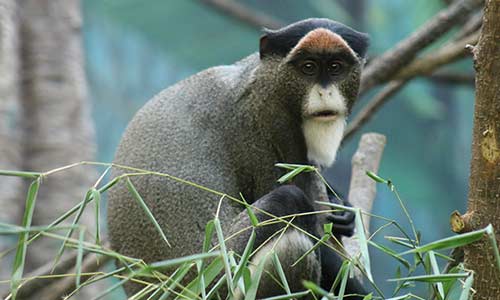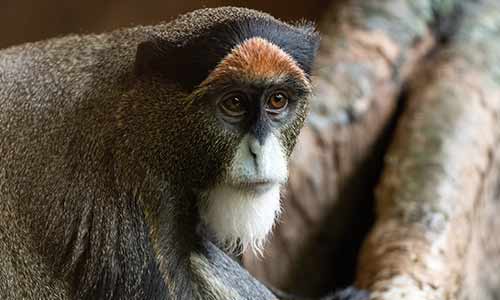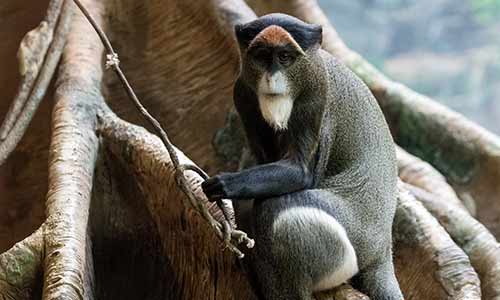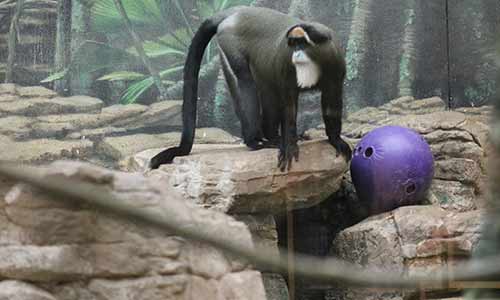De Brazza's Monkey
Cercopithecus neglectus
About the De Brazza's Monkey
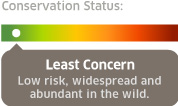
Geographic Range:
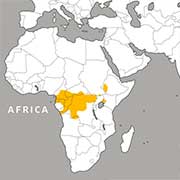
Class: Mammalia
Order: Primates
Family: Cercopithecidae
Genus: Cercopithecus
Species: neglectus
These monkeys are named for Pierre Savorgnan de Brazza, the Italian explorer that founded Brazzaville, the capital of the Republic of the Congo. Found in tropical forests in central Africa, they're known for the orange and white fur on their faces. These territorial monkeys live in small groups of up to 10 individuals with a dominant breeding male, adult females and their offspring. Though they're not endangered, habitat destruction and illegal hunting are causing this monkey's numbers to decline.
Committed to Conservation
Habitat loss for timber and agriculture (like coffee plantations) are a major threat to this species. Monkeys are also hunted for food and for the bushmeat trade, as well as collected for the pet trade.
Zoo New England participates in the De Brazza's monkey Species Survival Plan. By sharing research and knowledge, participating institutions work together to establish guidelines that best ensure the health of captive populations, and with success, the survival of endangered species.
As a partner with the Wildlife Trafficking Alliance, Zoo New England is part of a powerful coalition of more than 80 nonprofit organizations, companies and AZA-accredited aquariums and zoos working together to combat the illegal trade of wildlife.
You can help!
You can help preserve and protect wildlife habitat by shopping sustainably. Look for the RSPO and Rainforest Alliance labels before purchasing.
Think twice before purchasing an exotic pet. Millions of wild animals are taken illegally from their wild homes, so they can be sold as pets around the world. Owning an exotic pet is harmful to both animals and people—particularly from a wildlife trafficking and zoonotic disease perspective. Other reasons to avoid exotic pet ownership include the high cost of care and special food, veterinary and habitat needs.
De Brazza's Monkey Facts
Appearance:
De Brazza's monkeys coats are finely speckled gray and white with black extremities and tail. They have round heads, with a long white beard, white muzzle, and an orange crown. Thighs and rumps have white stripes. They have long legs, a non-prehensile tail and well-developed cheek pouches. Male De Brazza's monkeys have a distinct blue scrotum.
Size:
- Weight: Males weigh up to 15 pounds. Females weigh approximately 8.5 pounds
- Length: Ranges from 15-25 inches
Diet:
De Brazza’s monkeys are omnivorous, but primarily eat fruit. Other items in their diet include seeds, leaves, flowers, mushrooms, beetles, termites, worms and small reptiles. Foraging usually takes place in exposed areas. Food is stored in cheek pouches, and eaten when the monkeys return to safety.
Reproduction:
Females typically give birth to one infant (rarely, twins) that immediately clings to its mother’s stomach. Monkeys reach sexual maturity at 5-6 years of age, and breed throughout the year. The breeding season in equatorial forests is February to March, but De Brazza’s monkeys will breed whenever food is plentiful. Gestation lasts five to six months. Typically only one baby is born; twins are rare.
Behavior:
These arboreal monkeys forage for fruit and leaves in the tree canopy in the early morning and evening. Humans, eagles and leopards are their primary predators. De Brazza's monkeys freeze when alarmed. If they sense danger, the group will stand perfectly still while the alpha male shakes tree branches to take attention away from the other group members.
These territorial monkeys live in small groups of four to 10 individuals with a dominant breeding male, adult females and their offspring. Females nurse and care for their young until they become independent around 1 year of age. Females remain in their natal group all of their lives, whereas males disperse when sexually mature (5-6 years). Males then compete to control access to a group of females.
Habitat/range:
The range of De Brazza’s monkeys is a large triangle bordered by southern Ethiopia to the Northeast, Cameroon to the Northwest, and northern Angola to the south. The range runs through northern Gabon and Congo, and eastwards through much of the Democratic Republic of Congo and southern Central African Republic to eastern Uganda. Fragmented populations are also found in western Ethiopia, extreme southern Sudan and eastern Kenya. This species is more common in eastern Africa and less common in western Africa. De Brazza’s monkeys generally occupy forested regions close to rivers and waterways, including dense swamp forest, seasonally flooded areas, lowland tropical forest, and mountain forest up to elevations of 2,200 meters. They exist predominantly in the closed canopy and prefer dense vegetation.
Median Life Expectancy:
22 years in the wild
Fun Fact:
De Brazza's monkeys are excellent swimmers
Threats in the Wild:
Habitat loss for timber and agriculture, such as coffee plantations. Monkeys are hunted for food and for the bushmeat trade, as well as collected for the pet trade.
You Can Find This Animal in the Tropical Forest
Freeze!
If these stealthy primates sense danger, the group will freeze in place while the alpha male shakes tree branches to take attention away from the other group members.
You May Also Like
At Franklin Park Zoo:
At Stone Zoo:

